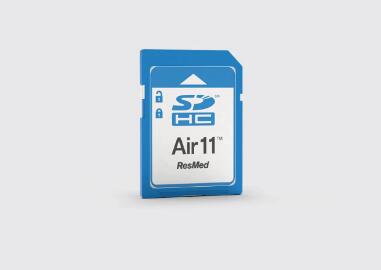The ResMed AirSense 11 CPAP machine is designed to use an SD card for storing data related to your therapy, such as usage statistics, therapy results, and other important information.
1. SD Card Specifications
Size and Capacity
Minimum Capacity: The AirSense 11 typically requires an SD card with a minimum capacity of 2 GB. This size is often sufficient for storing several months’ worth of data, given the relatively small size of the files it generates.
Recommended Capacity: For added flexibility and to accommodate future needs, a 4 GB or 8 GB SD card is generally recommended. These sizes provide more storage space without significantly increasing the cost.
Type
SD or SDHC: The AirSense 11 supports standard SD cards and SDHC cards. SDHC cards are commonly used and provide additional storage capacity beyond the traditional SD card.
Class: The card’s speed class is important for data transfer efficiency. For the AirSense 11. a Class 4 or higher SD card is generally sufficient. Class 4 cards have a minimum write speed of 4 MB/s, which is adequate for the data the CPAP machine generates. Class 10 cards, offering faster speeds, are also compatible and might be a better choice if you plan to use the card for other purposes or need faster data access.

2. Formatting the SD Card
Before using the SD card in your AirSense 11. it should be formatted correctly. The machine typically requires the card to be formatted in FAT16 or FAT32 file system. Most SD cards come pre-formatted with FAT32. but if you encounter issues, you may need to reformat the card using your computer:
Windows: Insert the SD card into your computer, go to “This PC” or “My Computer”, right-click on the SD card drive, select “Format”, and choose FAT32.
Mac: Insert the SD card, open “Disk Utility”, select the SD card, click “Erase”, and choose “MS-DOS (FAT)”.
3. Using the SD Card
Inserting the Card: Insert the SD card into the slot on the side of the AirSense 11. Ensure it is inserted correctly, as improper insertion can lead to errors.
Removing the Card: To remove the card, gently push it in to release it from the slot. Pull it out carefully.
4. Data Management
Data Storage: The SD card will store various types of data, including therapy usage, events, and compliance reports. Ensure you periodically back up this data if you wish to keep records beyond the card’s storage capacity.
Data Transfer: You can remove the SD card and insert it into a computer to view or manage the data. There are software applications available, including ResMed’s proprietary software, that can help you analyze the data collected.
5. Tips for Choosing and Using an SD Card
Buy from Reputable Brands: Choose SD cards from reputable brands like SanDisk, Kingston, or Lexar to ensure reliability and compatibility.
Avoid High-Capacity Cards: While higher-capacity cards are generally compatible, they might not provide additional benefits for the AirSense 11’s needs. A 4 GB or 8 GB card is typically more than sufficient.
Backup Data Regularly: To avoid losing important data, regularly back up your information to a secure location.
Check Compatibility: If you have any doubts about card compatibility, refer to the AirSense 11 user manual or consult with ResMed customer support.
About us and this blog
Panda Assistant is built on the latest data recovery algorithms, ensuring that no file is too damaged, too lost, or too corrupted to be recovered.
Request a free quote
We believe that data recovery shouldn’t be a daunting task. That’s why we’ve designed Panda Assistant to be as easy to use as it is powerful. With a few clicks, you can initiate a scan, preview recoverable files, and restore your data all within a matter of minutes.

 Try lt Free
Try lt Free Recovery success rate of up to
Recovery success rate of up to









